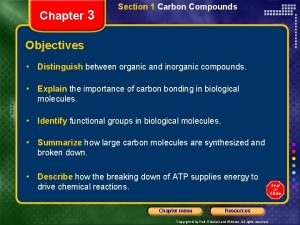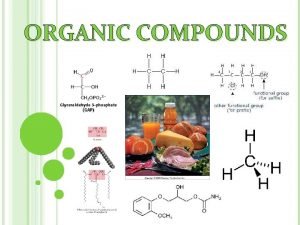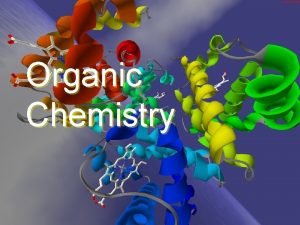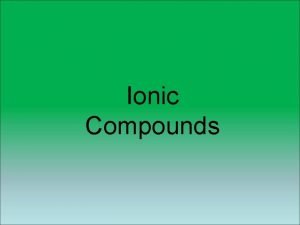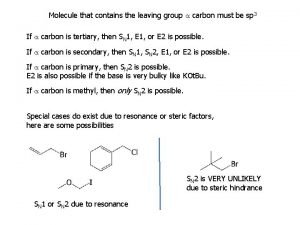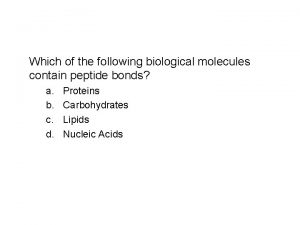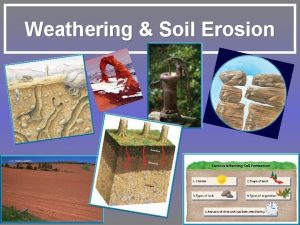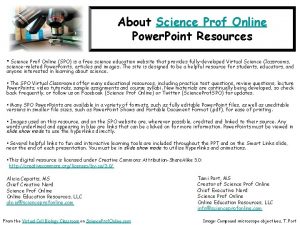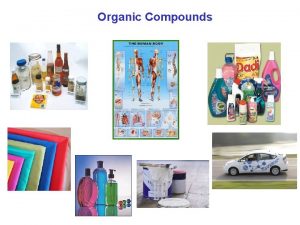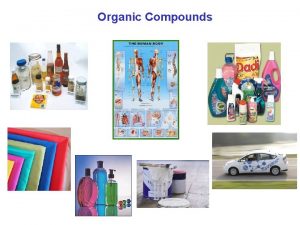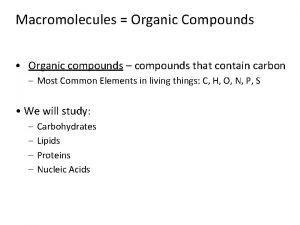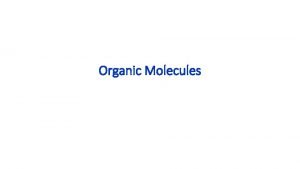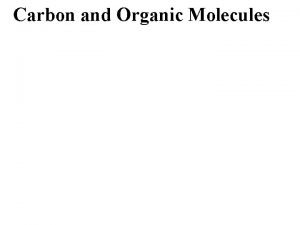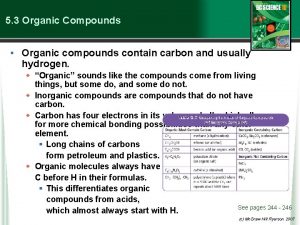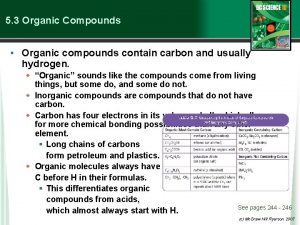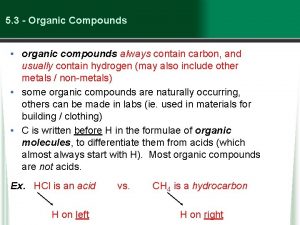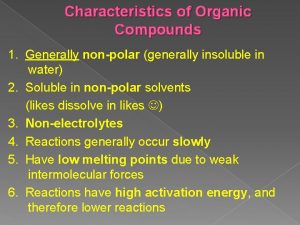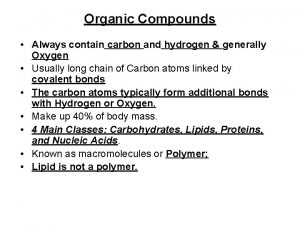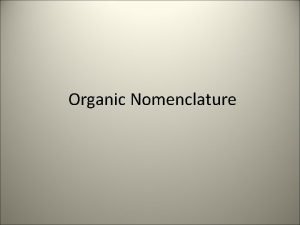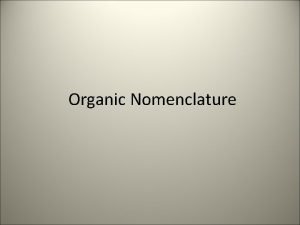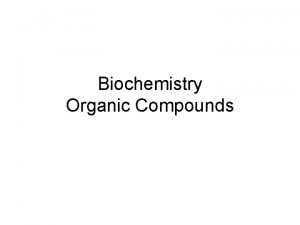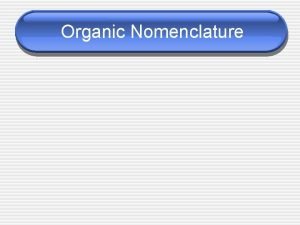Organic Compounds Organic Molecules Generally molecules that contain





















- Slides: 21

Organic Compounds

Organic Molecules Generally, molecules that contain carbon are organic Some exceptions are carbonates (CO 32 -), cyanides (CN-), simple oxides of carbon (CO), as well as diamond and graphite Diamond and graphite are allotropes of carbon— that is, they are just carbon, but in very different structural forms.

Organic Molecules / Hydrocarbons are organic molecules that contain only carbon and hydrogen. Methane, CH 4, is the simplest hydrocarbon.

Organic Molecules Other organic molecules may contain many other elements including halogens, metals, sulfur, oxygen, phosphorus, or nitrogen. I C 8 H 10 N 402

Organic Compounds Organic compounds make up the whole or part of innumerable products—some natural and some synthetic. Synthetic examples include: Plastics Explosives Paints Petrochemicals – hydrocarbons derived from petroleum that are used to make synthetic compounds such as plastic

Natural Examples: ? ? Remember in Biology!! 4 types of Organic Molecule: 1) Carbohydrates: sugars, starches (C, H, O) 2) Proteins: amino acids (C, H, O, P) 3) Nucleic Acids: DNA & RNA (C, H, O, N) 4) Lipids: Fats/Oils/Wax, Cell Membranes, Hormones. . (C, H, O, P, S) Pharmaceuticals aspirin, vitamins, insulin

Structure Organic molecules are constructed as carbon atoms form 4 stable, covalent bonds.

Structure These carbon structures can have single, double, or triple bonds. They can be straight chains or chains with branches. They can also form rings.

Alkanes: Saturated Hydrocarbons Remember: Hydrocarbons are molecules composed of C & H. Each carbon atom forms 4 chemical bonds A saturated hydrocarbon is one where all C - C bonds are “single” bonds & the molecule contains the maximum number of H-atoms. Saturated hydrocarbons are called ALKANES

Alkane Naming System Alkanes are named using a prefix + “ane. ” The prefix is determined by the number of carbons. An alkane with 1 carbon is called methane; 2 carbons is called ethane, etc. What Meth – 1 Pent – 5 Eth – 2 Hex – 6 Prop – 3 Hept – 7 But – 4 Oct – 8 would this alkane be called? Butane! What would this alkane be called? C 8 H 18 Octane!

Drawing Alkane Structures Using the prefix, determine how many carbons are in the chain. Connect each carbon with a single bond. Add hydrogens so that each carbon is saturated. Remember that carbon forms 4 bonds. For example, draw propane.

Alkenes and Alkynes Alkenes contain a double bond between adjacent carbon atoms. Alkynes contain a triple bond. • These hydrocarbons are called unsaturated because all of the bonds are NOT single bonds. Copyright © 2005 by Pearson Education, Inc. Publishing as Benjamin Cummings 12

Functional Groups Carbon atoms bound to each other form a backbone to which other atoms or groups of atoms are attached. These groups of atoms are called functional groups.

Dashes and Wedges Used to show 3 -D Straight lines are in the same plane Wedges come out of the plane Dashes go back into the plane

In the chart below, indicate under the name whether the compounds are hydrocarbons and if so, whether they are saturated or unsaturated. Circle and label any functional groups. The C-H bond is nonpolar. The presence of lone pairs produces a polarity. Polar substances will dissolve in a polar solvent such as water. Nonpolar substances will only dissolve in nonpolar solvents.

Structure CH 4 Methane C 2 H 6 Ethane C 2 H 4 Ethene C 2 H 2 Acetylene CH 3 CH 2 OH Ethanol CH 2 O Formaldehyde C 6 H 6 Benzene CH 3 COOH Acetic Acid

Structure / Polymers When organic molecules form long chains with repeating structural units, they are called polymers. These chains are flexible—the bonds in the backbone can swivel like paperclips hooked together.

Structure / Polymers can be natural or synthetic Natural: Proteins, cellulose, RNA, amino acids and DNA Synthetic: Plastic, nylon, and Kevlar Insulin (a protein)

Polymers Rubber

Properties of Organic Compounds Covalent bonds Low melting and boiling points Often liquids or gases at room temperature and pressure

Chemistry Joke Q: What did the bartender say when oxygen, hydrogen, sulfur, sodium, and phosphorus walked in? A: OH SNa. P!!!
 All organic compounds contain carbon and ________.
All organic compounds contain carbon and ________. All organic compounds must contain the element
All organic compounds must contain the element Organic compounds must contain:
Organic compounds must contain: Organic molecules vs inorganic molecules
Organic molecules vs inorganic molecules Are ionic compounds metals or nonmetals
Are ionic compounds metals or nonmetals Which molecules contain good leaving groups?
Which molecules contain good leaving groups? What biological molecules contain peptide bonds
What biological molecules contain peptide bonds Thể thơ truyền thống
Thể thơ truyền thống Hãy nói thật ít để làm được nhiều
Hãy nói thật ít để làm được nhiều Thơ thất ngôn tứ tuyệt đường luật
Thơ thất ngôn tứ tuyệt đường luật Gây tê cơ vuông thắt lưng
Gây tê cơ vuông thắt lưng Tôn thất thuyết là ai
Tôn thất thuyết là ai Phân độ lown
Phân độ lown Chiến lược kinh doanh quốc tế của walmart
Chiến lược kinh doanh quốc tế của walmart Sau thất bại ở hồ điển triệt
Sau thất bại ở hồ điển triệt Block nhĩ thất cao độ
Block nhĩ thất cao độ Tìm độ lớn thật của tam giác abc
Tìm độ lớn thật của tam giác abc A carbohydrate is an organic compound because it contain
A carbohydrate is an organic compound because it contain Weathering and soil erosion
Weathering and soil erosion Molecules vs compounds
Molecules vs compounds Atoms elements molecules and compounds worksheet
Atoms elements molecules and compounds worksheet All compounds are molecules
All compounds are molecules
